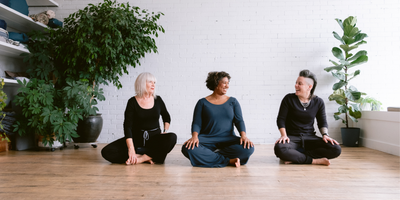Yin Vs. Restorative
You’ve likely heard how meditation can improve your mental health as well as your overall health. A quiet yoga practice can invite many of the same benefits, while also providing additional health benefits to the physical body.
Yin and Restorative Yoga are on the slow and sweet side of the asana practice. While they both share many similarities, they are unique practices with their own benefits.

Both practices require you to be present with yourself and your thoughts, they encourage you to rest, they are an offering of self care and self connection. They activate your parasympathetic nervous system which calms your body, and can have real impact on lowering stress levels.
If you’re wondering how to start meditating and want to ease into the practice, these slower, meditative practices may be a good entry point for you to build on.
ABOUT YIN YOGA

Yin Yoga targets the deep connective tissues including fascia, ligaments and joints with the goal of improving flexibility and strengthening the tissue of the joints. Poses are often held for 3-5 minutes, but can be held for longer. In yin, you may hear instructors talking about finding “your edge” - practitioners move into about 50-70% range of stretch, finding a gentle sensation that they can sustain for the longer held posture.
Continued awareness of your body allows you to notice any changes, or releasing of tension as the position is held; or alternatively, to back out of the posture if sensation becomes more intense. Breath is important in a yin practice because it allows you to focus on the breath during any uncomfortable (never painful, or tugging) sensations, and to utilize it to release any secondary tension that may arise though areas like the jaw, shoulders, and hands. Releasing tension through the body in this practice may help to release any areas of chronic tension and can have a powerful impact on the body and mind.

In some Yin classes, you may hear the instructor speak of meridians - referring to the subtle flow of energy through the subtle body. The modern Yin practice has been influenced by Daoist tradition (which led to Traditional Chinese Medicine), and addresses how Qi or Chi - the vital live force - travels through, or can be stuck in the body. The major meridians are named after the organ they affect. Your Yin teacher may sequence a class with the body’s Meridians and Qi/Chi in mind.
Props are used to help create space in target areas of the body, and in some poses to support your body so the muscles are able to relax and let go.
Common Props for Yin include; Bolsters, Prana Bolsters, Yoga Blocks, Sandbags, Straps, and Blankets.
ABOUT RESTORATIVE YOGA

While yin is about releasing and strengthening tissues, Restorative yoga is about overall relaxation. There’s a reason why some people consider these classes to feel like a “big hug”, or a “supported nap.” Restorative poses may be held for 5 - 20 minutes, and props are used to support your body, bringing you into comfortable, supported postures. All of this support and comfort allows for all of your tissues to relax. There is no effort required of the body, and one can shift into a space of being rather than doing. This support allows you to draw your awareness inward, and move into a more meditative state of being and a deeper state of conscious relaxation.

Restorative Yoga shifts the Nervous system from a Sympathetic Response (fight or flight) into a Parasympathetic Response (rest and digest). Relaxation of the body and mind through support, deep breathing, and a meditative state can help alleviate the effects of chronic stress and improve sleep. Both of these benefits can have a major impact on our overall wellbeing. This practice is gently on the body and is accessible for beginners, and beneficial for everyone. The only effort that is required on this practice is to pay attention to your breath and bring awareness to any sensations or thoughts that arise.
Useful Props for Restorative include; Bolsters, Prana Bolsters, Yoga Blocks, Sandbags, Straps, Blankets, Eye Pillows, Hand Weights, and Mini Round Bolsters.
QUIET PRACTICES AT HOME

Restorative and Yin practices are easy to do from home, can help manage psychological stress and anxiety, and improve your overall well-being. You can find an online class through a virtual studio or YouTube, set up your practice space with any props (or prop alternatives), blankets and essential oils, and settle into a practice to support both body and mind.




